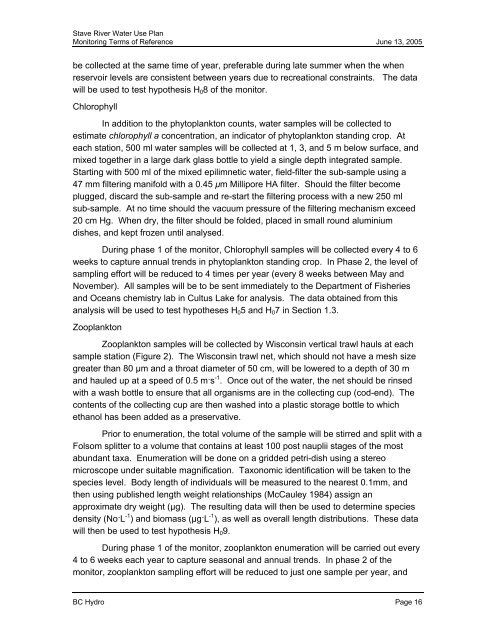Stave River Water Use Plan - BC Hydro
Stave River Water Use Plan - BC Hydro
Stave River Water Use Plan - BC Hydro
You also want an ePaper? Increase the reach of your titles
YUMPU automatically turns print PDFs into web optimized ePapers that Google loves.
<strong>Stave</strong> <strong>River</strong> <strong>Water</strong> <strong>Use</strong> <strong>Plan</strong><br />
Monitoring Terms of Reference June 13, 2005<br />
be collected at the same time of year, preferable during late summer when the when<br />
reservoir levels are consistent between years due to recreational constraints. The data<br />
will be used to test hypothesis H08 of the monitor.<br />
Chlorophyll<br />
In addition to the phytoplankton counts, water samples will be collected to<br />
estimate chlorophyll a concentration, an indicator of phytoplankton standing crop. At<br />
each station, 500 ml water samples will be collected at 1, 3, and 5 m below surface, and<br />
mixed together in a large dark glass bottle to yield a single depth integrated sample.<br />
Starting with 500 ml of the mixed epilimnetic water, field-filter the sub-sample using a<br />
47 mm filtering manifold with a 0.45 µm Millipore HA filter. Should the filter become<br />
plugged, discard the sub-sample and re-start the filtering process with a new 250 ml<br />
sub-sample. At no time should the vacuum pressure of the filtering mechanism exceed<br />
20 cm Hg. When dry, the filter should be folded, placed in small round aluminium<br />
dishes, and kept frozen until analysed.<br />
During phase 1 of the monitor, Chlorophyll samples will be collected every 4 to 6<br />
weeks to capture annual trends in phytoplankton standing crop. In Phase 2, the level of<br />
sampling effort will be reduced to 4 times per year (every 8 weeks between May and<br />
November). All samples will be to be sent immediately to the Department of Fisheries<br />
and Oceans chemistry lab in Cultus Lake for analysis. The data obtained from this<br />
analysis will be used to test hypotheses H05 and H07 in Section 1.3.<br />
Zooplankton<br />
Zooplankton samples will be collected by Wisconsin vertical trawl hauls at each<br />
sample station (Figure 2). The Wisconsin trawl net, which should not have a mesh size<br />
greater than 80 µm and a throat diameter of 50 cm, will be lowered to a depth of 30 m<br />
and hauled up at a speed of 0.5 m·s -1 . Once out of the water, the net should be rinsed<br />
with a wash bottle to ensure that all organisms are in the collecting cup (cod-end). The<br />
contents of the collecting cup are then washed into a plastic storage bottle to which<br />
ethanol has been added as a preservative.<br />
Prior to enumeration, the total volume of the sample will be stirred and split with a<br />
Folsom splitter to a volume that contains at least 100 post nauplii stages of the most<br />
abundant taxa. Enumeration will be done on a gridded petri-dish using a stereo<br />
microscope under suitable magnification. Taxonomic identification will be taken to the<br />
species level. Body length of individuals will be measured to the nearest 0.1mm, and<br />
then using published length weight relationships (McCauley 1984) assign an<br />
approximate dry weight (µg). The resulting data will then be used to determine species<br />
density (No·L -1 ) and biomass (µg·L -1 ), as well as overall length distributions. These data<br />
will then be used to test hypothesis H09.<br />
During phase 1 of the monitor, zooplankton enumeration will be carried out every<br />
4 to 6 weeks each year to capture seasonal and annual trends. In phase 2 of the<br />
monitor, zooplankton sampling effort will be reduced to just one sample per year, and<br />
<strong>BC</strong> <strong>Hydro</strong> Page 16
















